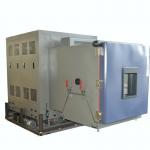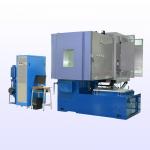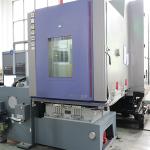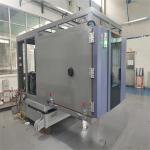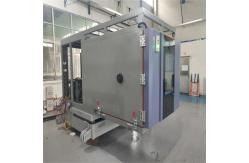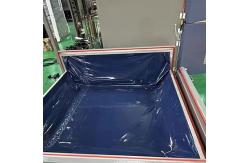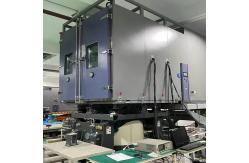In the rapidly evolving electric vehicle (EV) industry, the
reliability and performance of battery cells, modules, and packs
are of utmost importance. The Custom Climate Chamber with Vibration
Test is a cutting-edge solution designed to meet the specific and
demanding requirements of testing EV battery components. This advanced chamber is dedicated to simulating a wide range of
environmental and mechanical conditions that EV cells, modules, and
packs may encounter during their lifespan. It serves EV
manufacturers, battery research institutions, and testing
laboratories. The primary objective is to evaluate the durability,
safety, and performance of these components under various
temperature, humidity, and vibration stresses. By replicating
real-world scenarios, manufacturers can identify potential
weaknesses, optimize battery designs, and ensure compliance with
industry standards and safety regulations. - Robust and Insulated Chamber Structure
- The chamber is constructed with a heavy-duty steel frame and
insulated walls. The steel frame provides exceptional strength and
rigidity, ensuring the chamber can withstand the rigors of
continuous vibration testing. The insulation materials are
carefully selected to minimize heat transfer and maintain stable
temperature and humidity levels. The door is equipped with a
reliable sealing mechanism and a viewing window, allowing operators
to monitor the test process without disturbing the internal
environment. The interior of the chamber is designed with smooth,
easy-to-clean surfaces to prevent any particulate or contaminant
buildup that could affect the test results.
- Precision Temperature and Humidity Control System
- At the heart of the chamber lies a sophisticated temperature and
humidity control system. It can achieve a wide temperature range,
typically from -40°C to +80°C, with an accuracy of ±0.3°C. The
humidity control range extends from 10% to 95% relative humidity,
with an accuracy of ±2% RH. The system utilizes energy-efficient
refrigeration units, heaters, humidifiers, and dehumidifiers, all
coordinated by a precise PID controller. Multiple temperature and
humidity sensors are strategically placed throughout the chamber to
provide real-time feedback, enabling the control system to make
rapid and accurate adjustments.
- Advanced Vibration Testing Capability
- The chamber is equipped with a state-of-the-art vibration testing
system. It can generate a wide range of vibration frequencies and
amplitudes, simulating the vibrations that occur during EV
operation, such as driving on rough roads or during acceleration
and deceleration. The vibration table is designed to provide
uniform vibration across the test samples, ensuring accurate and
reliable testing. The system can be programmed to replicate
specific driving profiles or industry-standard vibration tests,
allowing manufacturers to evaluate the effect of vibrations on the
integrity and performance of EV battery components.
- Intuitive Control Panel and Data Acquisition Interface
- The equipment is equipped with an intuitive control panel that
simplifies the operation and parameter setting. Operators can
easily adjust the temperature, humidity, vibration parameters, test
durations, and other settings using a user-friendly interface. The
control panel also provides real-time displays of the current
environmental conditions, vibration status, and any alarms or
warnings. The chamber is integrated with a comprehensive data
acquisition system. It records all relevant test data, including
temperature and humidity histories, vibration profiles, and any
observable changes in the test samples. The data can be stored in a
built-in memory or exported to external storage devices for further
analysis. The system can also generate detailed test reports in
various formats, facilitating easy documentation and sharing of
results.
- Safety Features and Alarms
- To ensure the safety of operators and the integrity of the testing
process, the chamber is equipped with a range of safety features.
These include over-temperature and over-current protection,
emergency stop buttons, and alarms for abnormal temperature
fluctuations, humidity levels, or vibration patterns. The safety
features are designed to prevent damage to the chamber, the test
samples, and the surrounding environment, providing peace of mind
during the testing operation.
- Temperature Range and Accuracy
- With a temperature range of -40°C to +80°C and an accuracy of
±0.3°C, the chamber can subject EV battery components to a wide
spectrum of temperatures. This is crucial for testing the
performance and durability of batteries in extreme cold and hot
conditions, such as during winter driving or in high-temperature
environments. The accurate temperature control ensures that the
test conditions are precisely maintained, providing reliable and
repeatable results.
- Humidity Range and Accuracy
- The humidity range of 10% to 95% RH, with an accuracy of ±2% RH,
allows for a comprehensive evaluation of the effect of moisture on
EV battery components. High humidity can affect the corrosion
resistance of battery terminals and the integrity of the battery
casing, while low humidity can cause drying and cracking of certain
materials. The ability to precisely control the humidity level is
essential for understanding how batteries respond to different
moisture environments.
- Vibration Parameters
- The vibration testing system can generate frequencies ranging from
5 Hz to 500 Hz and amplitudes up to 50 mm. These parameters can be
adjusted to simulate various driving conditions, from the gentle
vibrations of city driving to the more severe shocks and vibrations
of off-road or high-speed driving. The ability to accurately
control the vibration characteristics is vital for assessing the
durability and integrity of EV battery components and their
connections.
- Testing Volume and Payload Capacity
|
